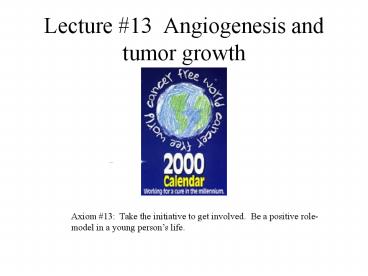Lecture - PowerPoint PPT Presentation
1 / 26
Title: Lecture
1
Lecture 13 Angiogenesis and tumor growth
Axiom 13 Take the initiative to get involved.
Be a positive role-model in a young persons
life.
2
Tumors require the continuing formation of new
blood vessels
- Supply oxygen and nutrients
- Supply endocrine and paracrine growth-enabling
factors
Want a hot stock tip? Invest in a pharmaceutical
company that sells blood pressure medication.
According to some recent research, Americas high
divorce rate is creating a population of young
hypertensives.
3
Microvascular endothelial cells that line
capillary blood vessels are situated very close
to normal tissue cells such as epithelial cells
in the gut mucosa
Tumor cells form multiple layers around a
capillary Ergo most distant tumor cells are
oxygen deprived
- Islet cells of pancreas, fat cells and muscle
cells are similarly arranged. - Liver cells arranged around a central capillary
- Epithelial cells in crypts (100 um distance from
vessel)
4
THM 1
- Tumor cell survival is dependent on the health
and proliferation of endothelial cells in
surrounding blood vessels.
5
How Does Radiation Therapy Work? (e.g. what is
the molecular basis for cell death)
- Yes, there is a link between tumor growth and
growth of healthy tissue.
6
Old View
- Radiation causes breaks in DNA, cell undergoes
apoptosis. - Side effects in GI syndrome (Gut)
- due to apoptosis of healthy epithelial cells
- in mucosa
7
New data suggesting that radiation kills stem
cells indirectly.
- Death of epithelial stem cells in gut may be a
secondary event resulting form the demise of the
endothelial cells on which they depend. - (Richard Kolesnick Science 29313 July, 2001
MSKCC)
8
What is the molecular mechanism of endothelial
cell death?
- Irradiation of microvascular endothelial cells
generates ceramide an apoptotic signalling
molecule.
9
Effects of radiotherapy on intestinal mucosa and
bone marrow
Small intestine mucosa
- Note bFGF doesnt protect bone marrow!
- Why? Guess which tissue doesnt have receptors
for bFGF?
Loss of villi
Science 29313 July, 2001 MSKCC
10
Can microvasculature be protected from gut
irradiation?
- Yes, Systemic administration of (basic Fibroblast
Growth Factor (bFGF)- an endothelial cell
mitogen. - What else can you do? What about inhibition of
enzyme that makes ceramide? (sphingomyelinase)
11
Effects of radiotherapy on intestinal mucosa and
bone marrow
Small intestine mucosa
Loss of villi
Why doesnt bFGF protect bone marrow?
Gray (Gy) unit of radiation
12
Some tumors are more resistant to radiotherapy
than others
- Hodgkins lymphoma very sensitive
- Glioblastoma radioresistant
- Improve therapeutic index of radiation by
- deprotecting (combination therapy) the tumor or
- protecting normal tissue (bFGF).
13
Is apoptosis in healthy and diseased cells
related?
- Yes The molecular details of healthy tissue
death following radiotherapy is similar to the
way in which tumor growth is inhibited by
endothelial cell blockers - ANTIANGIOGENIC THERAPY
- 200 biotech and big pharma companies are
pursuing angiogenesis research
14
Inhibition of angiogenesis can retard
experimental tumor growth and metastasis
Fig. 16.20 Angiogenesis and tumor growth
15
If tumor growth is limited by rate of oxygen
diffusion to 200 um, how can a tumor grow to be
several inches?
- Tumors release bFGF (endothelial mitogen)
- VEGF (Vascular Endothelial Growth factor)
- Ergo tumor cells stimulate their life support
system!
100-200 um
16
Tumor vasculature actively supports cell
proliferation!
- Endothelial cells protect tumor cells by
releasing at least 20 growth and survival factors
- e.g. heparin-binding epithelial growth factor
- interleukin
(e.g. acute wound healing, chronic wounds from
diabetes, arteriosclerosis, venous ulcers,
pressure sores)
17
Tumor growth is dependent on angiogenesis
- Ergo, tumor vasculature is an attractive target
for cancer therapy
18
Anti-angiogenic drugs
- Endostatin generated by proteolysis of a larger
extracellular protein-- collagen XVIII - Works by binding to tropomyosin in endothelial
cells! JBC 276pp.25190-25196, 2001 - Lowers VEGF levels, most successful in sarcomas
and melanomas - Angiostatin generated by proteolysis of a larger
extracellular protein plasminogen - 2-methoxyestradiol Panzem
19
This is not a magic bullet?Problems
- Repeated injections
- Prolonged treatment
- Transmission of toxins and infectious particles
- High cost of manufacturing large amounts of
protein molecules - Alternative strategies!
20
Joki et al., Nature Biotechnology 1935-39 2001
- Genetically engineer kidney epithelial cells to
express endostatin, then encapsulate the cells
in sodium alginate containing 1,4-b-D-mannuronic
and a-L guluronic residues - The mixture of alginate and cells solidifies into
beads, spheroids, that contain immobilized cells
in and artificial extracellular matrix that
allows free exchange of proteins, nutrients, and
oxygen between encapsulated cells and the host. - The alginate beads protect the encapsulated cells
from tissue rejection - Beads are resistant to enzymatic digestion
21
Joki et al., Nature Biotechnology 1935-39 2001
- Endostatin cell factories reduce tumor growth by
gt70 - Increase in intratumoral apoptosis
- Increase in large necrotic areas near tumor
- But tumor is still present!
- Encapsulated cells remain alive for up to 4
months. If they cut off vascular nutrition, how
do they stay alive? - Unable to prevent growth of nascent or small
tumors, but did delay tumor growth
22
How can the efficacy be improved?
- More beads?
- Beads with different cells?
- Different endostatin expression vectors?
- Increase inhibitor levels
- Combining implantation of anti-angiogenic cells
factories with another therapeutic
strategychemotherapy?
23
Fig. 16.21 Response of a solid tumor to
treatment with angiogenesis inhibitors.
Tumor is not ameliorated!
24
Diagram illustrates tumor progression from a
hyperplastic, premalignant stage through the
'angiogenic switch' to an invasive, metastatic
cancer
- Tumorstroma communication during tumor
progression.. The colored arrows indicate lines
of communication between tumor cells and
surrounding stromal components of the tumor,
including fibroblasts, endothelial cells,
inflammatory cells and structural matrix
components. The gold arrows may be representative
of the contribution of matrix metalloproteinases,
which represent a greater proportion of the
communication signals in early, as compared to
later stages of tumor progression.
25
End Review of first 2 topics
26

